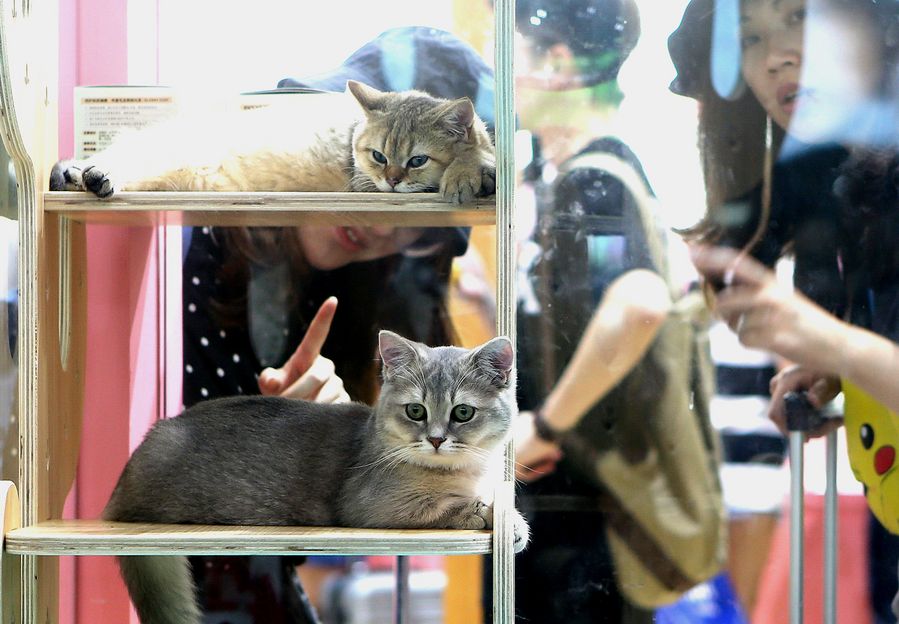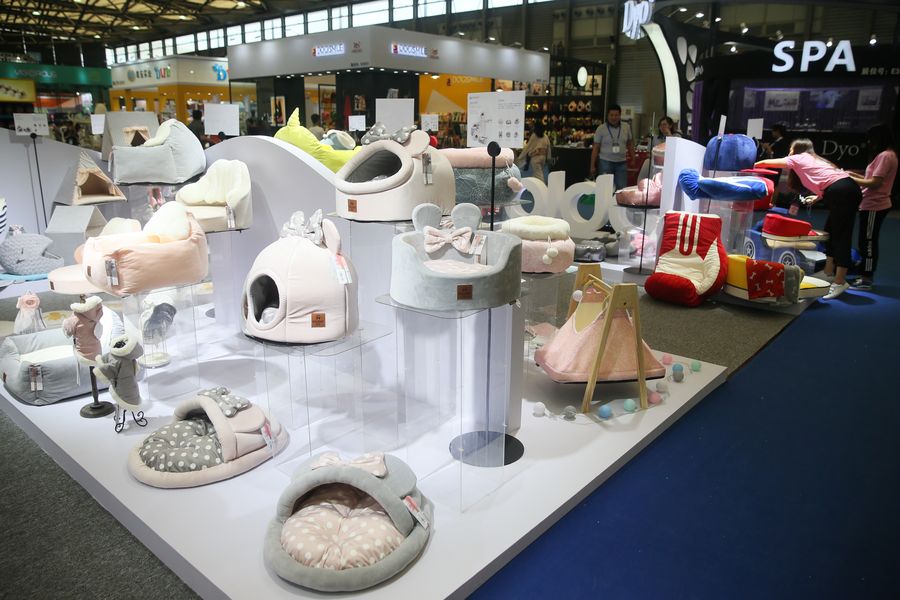
People watch cats during the 22nd Pet Fair Asia in Shanghai, east China, Aug. 24, 2019. (Xinhua/Chen Fei)
The pet consumption market is exploding in China. According to CBNData's Big Data Report on Pet Consumption Ecology in 2019, the pet market in China reached 172.2 billion yuan in 2018, more than three times what it was five years ago.
Online pet consumption has also entered a period of rapid development. Almost 90 percent of pet users have bought pet products online, and the online pet consumption market has grown by about 30 percent in the past year.
BEIJING, Sept. 13 (Xinhua) -- Liu Daixi, 30, is a mother of two. Just like any other mom, She cares about the health and happiness of her "babies" and always buy them the latest toys and cute clothes.
"I spend an average 600 yuan (about 85 U.S. dollars) a month on them, but if include the medical expenses, the annual expenditure could be around 20,000 yuan," said Liu, in the city of Nanning, south China's Guangxi Zhuang Autonomous Region.
Compared to Liu, her friend Tang Chang'an, is some sort of a "crazy" mom. "I spend an average 30,000 yuan a month on my kids," said Tang in Shanghai, who keeps 16 naughty kids. The babies in their words are actually their pets.
Tang's day begins at around 9 a.m., which she jokes "the worst time of the day." "I have to open seven to eight super large cans to stop them from crying for food," she said.
"But they are so cute and lovely," said Tang. "They are always by your side when you need them."
And also, Tang loves showing off her little ones and is passionate about sharing their updates in chat groups. She is a member of 14 pet-raising groups, and each has at least 70 to 80 members.
"I love taking photos of my two cats and posting one or two tweets about them every day," said Liu. "We often share feeding time and funny poses and expressions they make in chat groups."
The pet consumption market is exploding in China. According to CBNData's Big Data Report on Pet Consumption Ecology in 2019, the pet market in China reached 172.2 billion yuan in 2018, more than three times what it was five years ago.
Online pet consumption has also entered a period of rapid development. Almost 90 percent of pet users have bought pet products online, and the online pet consumption market has grown by about 30 percent in the past year.

Photo taken on Aug. 21, 2019 shows pet supplies exhibited at the 22nd Pet Fair Asia 2019 in Shanghai, east China. (Xinhua/Ding Ting)
Women and young people are the main consumers. The report showed that about 60 percent of those who purchased pet products online over the past year were female, and 40 percent were those born after 1990. They also accounted for nearly half of the users who posted short videos of pets on Chinese short-video and live-streaming platform Kuaishou during the same period.
Geographically, new first-tier cities saw the highest growth in pet consumption, accounting for more than a quarter of the total. Among them, Chengdu has the largest online pet consumption market, and Dongguan registered the highest growth rate among the new first-tier cities. Overall, pet owners in Shanghai are most generous in spending money on their furry friends, followed by Beijing, Hangzhou, Nanjing and Shenzhen.
Pets are also experiencing an upgrade in consumption in China. The report shows that the pet food market has changed significantly over the past decade.
Canned cat food is still Tang's main expense. In addition, she buys a variety of nutrients for her "children." She listed off more than 10 such supplements which included vitamins, coenzyme Q10, probiotics, potassium iodide, lactoferrin, taurine powder, fish oil, and many others.
Data in the report shows that online consumption of cat and dog nutrition has increased by more than 50 percent for two consecutive years, and customized pet food is also becoming increasingly popular.
"I usually go to the pet store to buy custom-made dog food which is designed for pets at different ages," said Wang Hong, who has been raising a black-and-white Husky for eight years.
Like raising children, pet owners also face the problem of work-life balance. Unwilling to make their beloved animal friends "empty nest pets," many purchase intelligent devices to take care of their animals while they are away.
According to the report, nearly 40 percent of online consumers of pet smart devices are people born after 1990. The most well-received devices include monitoring equipment and intelligent feeding.
A new range of pet services, including pet behavior training, sports and entertainment, as well as pet movie theaters, have also emerged to meet the new trends.
"It feels like pet owners are more willing to spend money now. Pet furniture and appliances are fairly common, the owners often take their beloved ones for family and portrait photos and pet products are becoming smarter, "said Liu.



